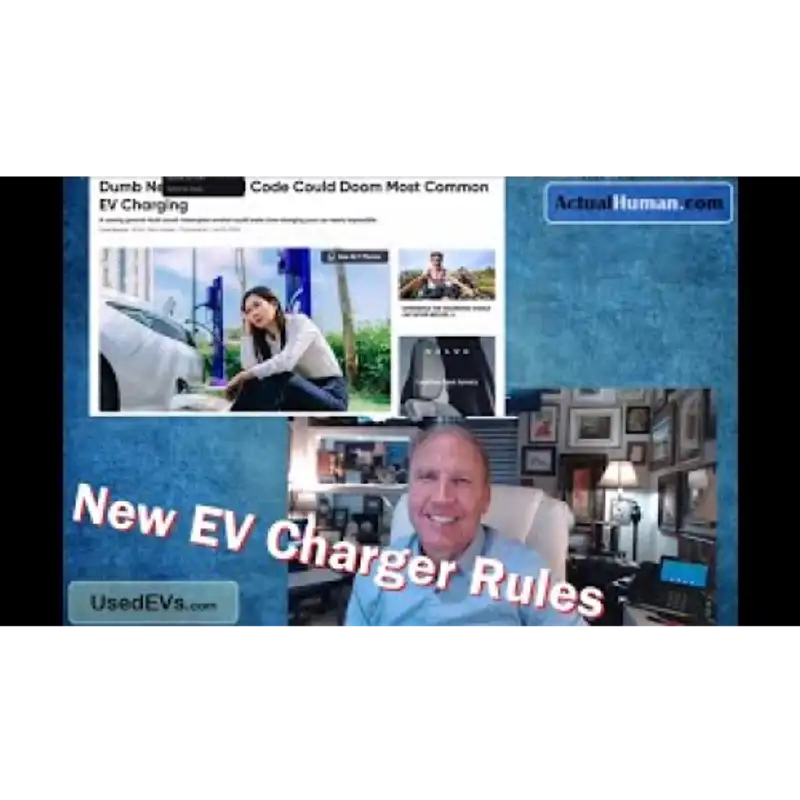EV Home Charger Law: A Threat to Reliability?
Download MP3You guys are going to hate this one. So, if you're at all in the space of doing general contracting or building, or if you're just a person who likes electric vehicles and are thinking about getting an EV or have one, you're going to hate this new law—this new rule that's coming out in the NEC electrical code in 2026.
Every three years, the NEC comes out with new codes for contractors, and we're a licensed general contractor, so we see these codes. What they're going to start requiring next year is on all EV charging household plugs that you usually have in your garage, they're going to require what's called the GFI (Ground Fault Interrupter) or GFCI (Ground Fault Circuit Interrupter).
You're familiar with these plugs—like the ones in your bathroom or kitchen, where you have that little button. If the breaker trips, you push the button, and it resets. The purpose of that is to prevent electrocution in wet environments like bathrooms, kitchens, outdoors, or even garages. If you accidentally touch an outlet or something that's not grounded while standing in water, the GFCI prevents you from getting shocked.
Up until now, EV charging plugs didn’t require a GFCI, even though most of them are in garages where this protection is needed. But under the new NEC code, they will be required. Now, when you plug in your EV to charge overnight, keep in mind that EVs run on 240-volt circuits (two 120V lines connected together), which experience large fluctuations in voltage. A GFCI is designed to detect small fluctuations as low as 5 volts, and if that happens naturally, it will trip the breaker—just like when you run a blender and a microwave at the same time and the breaker pops.
So, now you get up in the morning to go to work, only to find that your EV has no battery because it never charged overnight—the circuit popped. The worst part? The reset button for EV plugs is not allowed to be on the plug itself. It has to be on the circuit breaker box or the service entrance panel.
If your breaker box is in the garage, no big deal. But what if it’s in the basement? You’ll have to go downstairs, reset it, then go back up to check if it worked, and hope it doesn’t trip again. This is a big deal for EV owners, especially those with a dedicated hardwired EV charging plug—or those considering getting one.
If you’re thinking about getting an EV in the future, you might want to install a charging circuit in your garage now before this new NEC code takes effect. Otherwise, you could find yourself dealing with a charger that keeps shutting off, without even knowing it.
There really should be an exception to this rule. EV chargers aren’t electrified until they detect that they’re connected to a car. Unlike old electrical outlets where you could stick a paperclip in and get shocked, an EV charger won’t send electricity until it recognizes a vehicle is plugged in.
This is a big change for the construction industry and EV owners. If you have more than one EV charger on the same circuit—like at a car dealership with multiple chargers—the fluctuations in voltage could be massive, causing frequent shutdowns. Unless the NEC makes an exception or changes this rule, many EV owners could find themselves unable to drive to work in the morning because their car never charged.
Thank you for watching another video at ActualHuman.com and Describe.TV. Remember, if you have questions or comments about our videos, leave them in the link below.
Also, remember that you have access to live one-on-one consultations with licensed experts in various fields—including investigations, insurance, surety bonds, civil court mediation, real estate records research, mortgage lending, business development, marketing, advertising, and more.
If you found this content valuable and want to dive deeper into the subject, remember—you can’t ask YouTube a question. But you can talk to an actual human. Use the link below.
Thanks for watching!

